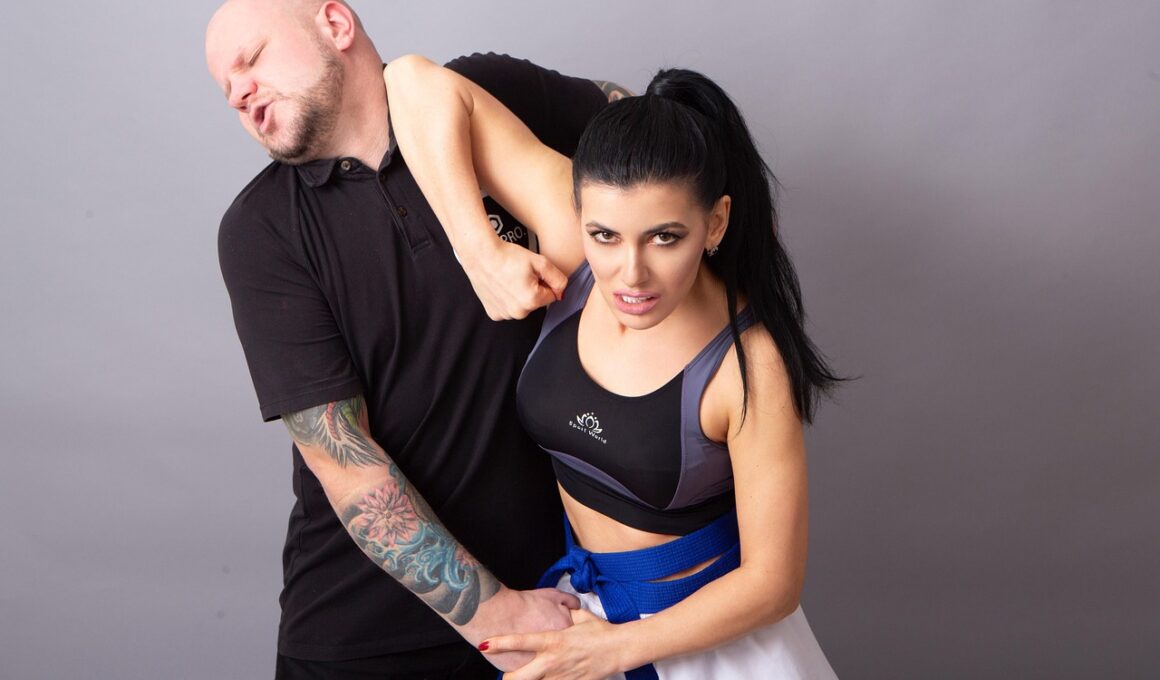Setting Goals to Track Progress in Your Block and Parry Training
Tracking your progress in block and parry training can significantly enhance your self-defense skills. Setting clear and measurable goals enables you to observe your advancements and refine your techniques. Start by defining specific objectives regarding the number of practices per week, focusing particularly on each movement’s precision and timing. Consider implementing a diary to log your practice sessions, which will help monitor your performance over time. Consistency is key; thus, committing to a schedule can greatly improve your results. Moreover, enrolling in a self-defense class can provide expert guidance and accountability, serving as a motivator to achieve your targets. As you grow more familiar with various techniques, progressively raise the difficulty of your objectives. Crafting both short-term and long-term goals fosters continuous motivation. Celebrate your milestones, no matter how small they might seem, as these victories contribute to an overall sense of achievement. Align these goals not only with skill development but also with personal aspirations in self-defense, empowering you to stay focused and driven in your training journey. Lastly, always seek feedback from peers or instructors to gain external perspectives and insights.
Feedback is essential for improvement, especially in self-defense training. Engaging with instructors or fellow practitioners creates an opportunity to learn and adapt. This can include drills that emphasize techniques you wish to enhance, particularly block and parry maneuvers. Set goals around receiving feedback, such as making it a point to ask for critiques after every training session. It can encourage an open dialogue about strengths and weaknesses in your techniques. Additionally, implement structured sparring sessions to practice your blocks and parries under pressure in a controlled environment. These sparring experiences are crucial as they allow you to test your skills against a live opponent. You might want to set a goal related to the amount of time spent sparring each week. Using video recordings of your technique can also be a valuable tool; this allows you to analyze your performance critically. Once you review your footage, take note of areas requiring improvement, and adjust your training accordingly. By incorporating various learning methods, you not only track progress but also maintain motivation. Ultimately, all these methods lead to a holistic growth experience in your block and parry capabilities.
One effective approach to tracking your block and parry training is to develop a structured scoring system. Create a chart where you can quantify your performance based on specific criteria, such as accuracy, reaction time, and stamina during practice. This data will provide insights into your progress, illuminating areas for improvement. You might categorize your skills into beginner, intermediate, and advanced levels corresponding to your goals. While the scoring system keeps things objective, consider blending qualitative feedback from peers and instructors to capture nuances in your techniques. Both quantitative and qualitative feedback are essential for holistic improvement. To keep yourself motivated, set thresholds to work toward, motivating yourself as you hit higher score averages over time. Over time, adapt your goals as you achieve your targets, ensuring that they remain challenging yet attainable. Incorporate visualization techniques to envision your success in specific scenarios where your blocks and parries would be applied. This mental practice can significantly impact actual performance during live training. Lowering the chance of injury stems naturally from improved strategies for blocking and parrying, further enhancing your self-defense skills within real-world contexts.
Incorporating Mindfulness into Your Practice
Mindfulness can dramatically enhance your training in block and parry techniques. By becoming more aware of your body movements and the environment around you, you can improve the effectiveness of your defensive maneuvers. Setting goals related to mindfulness might include dedicating the first few minutes of practice to focus solely on your breathing and body position. Concentrating on your state of mind can provide clarity and help manage any stress associated with training sessions. Try to incorporate specific mindfulness techniques, such as visualization, where you imagine successfully executing your blocks and parries against an opponent. This mental rehearsal strengthens neural pathways, making actions reflexive. Maintaining a strong mental attitude will help boost your confidence during sparring or self-defense scenarios. Even while practicing technique repetitively, engaging in mindfulness elevates the training experience, as it fosters self-reflection. After every practice session, take a moment to evaluate how mindful you remained throughout. Document your findings, noticing patterns in behavior over time. Focus on improvement as you integrate mindfulness into your sessions, and how this can affect your efficiency during critical moments. This holistic approach can yield substantial benefits for your performance.
In addition to mental approaches, physical aspects cannot be overlooked while tracking progress in block and parry training. Setting fitness-based goals is crucial, as strength, flexibility, and endurance directly influence your defensive abilities. Consider integrating fitness assessments into your practice regimen. For example, dedicate certain days to focus on strength training specifically aimed at enhancing muscles relevant for blocking and parrying actions. Conditioning drills can be tailored to mimic the movements you need, forming a solid foundation for your skills. Track improvements in physical capabilities by recording weights and repetitions. Aim to enhance not just muscle strength but also core stability and agility, facilitating faster reactions. Encourage diversity in your training plan by including cross-training activities, such as yoga or Pilates, which improve overall body awareness and flexibility. These activities can greatly enhance your ability to execute blocks and parries swiftly and accurately, reducing the risk of injury. Make fitness goals measurable over specific timeframes, offering valuable insights into your overall progression. This multifaceted approach ensures that you’re developing necessary physical capabilities alongside your technical skills in self-defense.
Consistency is foundational in achieving success in block and parry training. Without a routine, it becomes easy to stray from your goals. Establish a training schedule committing to regular practice; ideally, aim for several sessions each week. Document your attendance and duration meticulously in your log, ensuring you maintain an optimal frequency. It may also be beneficial to set specific timeframes for each practice, segmenting the focus areas for more productive sessions. For example, allocating certain times for block drills versus parrying exercises may yield better results. To enhance consistency, enlist a training partner who can help hold you accountable or even join a community focused on self-defense to share your journey. Embrace accountability by articulating your goals; this opens doors for outside encouragement and feedback. Regularly reassess your practice frequency to ensure it matches your evolving goals. When obstacles arise, don’t be discouraged; using these instances as learning experiences can bolster motivation. Celebrate each achievement, not just significant milestones, as they all contribute to your overall skill development. Consistent training not only builds muscle memory but also instills greater confidence in employing block and parry techniques.
Reflect and Reassess Your Goals Regularly
Periodically reflecting on your training journey is crucial in block and parry practice. Growth doesn’t happen linearly; therefore, reassessing your goals allows you to adapt according to your progress and motivations. Set a routine to evaluate your training objectives regularly, assessing how well they align with your current abilities and interests. Ask yourself crucial questions during these evaluations: Are your goals still relevant? Are you experiencing any challenges that necessitate adjustments? Seeking honest answers provides insights going forward, as they enable you to enhance your training plan effectively. Revising goals based on promotion or skill level can also add excitement. Including new challenges can rekindle your enthusiasm, preventing any sense of stagnation. Create a vision board or other visual reminders showcasing your goals and aspirations in self-defense training. This visual aspect can keep you motivated and engaged. Maintain flexibility; sometimes, your focus may shift, and that’s natural in your training journey. Continuously adapt your goals based on reflection and learning experiences. By practicing this intentional approach, you ensure a refreshing perspective on your self-defense practice while tracking meaningful progress toward achieving your ultimate self-defense capabilities.
Ultimately, the journey of tracking progress in block and parry training epitomizes a commitment to personal safety and health. Through goal-setting, consistent practice, feedback, and adaptation, you will not only measure your abilities but also cultivate a mindset geared toward growth. Emphasize the reciprocal relationship between mental and physical development, ensuring holistic progress. Each element from establishing clear goals to integrating mindfulness supports an enriching training experience. Celebrate your achievements, validate your resilience, and always aspire for growth, no matter how small the steps might be, as they contribute significantly over time. The journey requires dedication; thus, tracking every step creates clarity, showing how far you’ve come. Engaging with peers and instructors enriches the experience while reinforcing accountability and motivation. Regular assessments foster adaptability in the face of challenges, proving that perseverance pays off in self-defense mastery. Your successful practice of block and parry techniques strengthens not only your physical defenses but also your confidence in handling real-life situations. Ultimately, the visualization and mental rehearsal techniques integrate seamlessly into physical practice. Embrace this comprehensive approach, ensuring that tracking your progress translates into empowered self-defense capabilities that shape a safer life experience.


